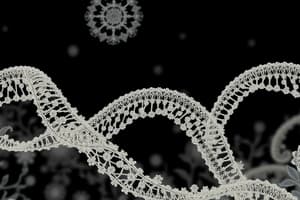Podcast
Questions and Answers
What is a characteristic of Single-Molecular Real-Time Sequencing (SMRT) that allows for accurate sequencing?
What is a characteristic of Single-Molecular Real-Time Sequencing (SMRT) that allows for accurate sequencing?
- Use of Sanger sequencing technology
- Parallelized sequencing and fluorescence detection (correct)
- Amplification of DNA molecules before sequencing
- Sequencing of short DNA molecules
Which of the following is a limitation of Nanopore Sequencing?
Which of the following is a limitation of Nanopore Sequencing?
- Difficulty in extracting and delivering high-molecular weight DNA (correct)
- High cost of the Oxford Nanopore MinION device
- Short read lengths
- Need for complex libraries
What is an application of Single-Molecular Real-Time Sequencing (SMRT) in medicine?
What is an application of Single-Molecular Real-Time Sequencing (SMRT) in medicine?
- Studying the microbiome of the human gut
- Detecting gene mutations in cancer cells
- Sequencing of entire human genomes
- Detecting drug resistance in Chronic myeloid leukemia (correct)
What was 454 sequencing used for, despite its high error rates and high cost?
What was 454 sequencing used for, despite its high error rates and high cost?
What is an advantage of Nanopore Sequencing over other sequencing technologies?
What is an advantage of Nanopore Sequencing over other sequencing technologies?
What is a limitation of Polony sequencing?
What is a limitation of Polony sequencing?
What is a characteristic of Third-Generation Sequencing technologies?
What is a characteristic of Third-Generation Sequencing technologies?
What is a characteristic of Illumina technology?
What is a characteristic of Illumina technology?
What is an application of Nanopore Sequencing in agriculture?
What is an application of Nanopore Sequencing in agriculture?
What is NOT a use of 454 sequencing?
What is NOT a use of 454 sequencing?
What is a strength of Polony sequencing?
What is a strength of Polony sequencing?
What is a limitation of Single-Molecular Real-Time Sequencing (SMRT)?
What is a limitation of Single-Molecular Real-Time Sequencing (SMRT)?
Why is Illumina technology popular among scientists?
Why is Illumina technology popular among scientists?
What is a feature of Nanopore Sequencing that allows for direct detection of nucleotides?
What is a feature of Nanopore Sequencing that allows for direct detection of nucleotides?
What is the primary advantage of High-throughput Sequencing (HTS) over traditional Sanger sequencing?
What is the primary advantage of High-throughput Sequencing (HTS) over traditional Sanger sequencing?
Which technique is commonly used in Massively Parallel Sequencing (MPSS) to label genetic material?
Which technique is commonly used in Massively Parallel Sequencing (MPSS) to label genetic material?
What is another name for Massively Parallel Sequencing (MPSS)?
What is another name for Massively Parallel Sequencing (MPSS)?
What is a key application of Massively Parallel Sequencing (MPSS)?
What is a key application of Massively Parallel Sequencing (MPSS)?
What is the main difference between 454 sequencing and traditional Sanger sequencing?
What is the main difference between 454 sequencing and traditional Sanger sequencing?
Which of the following is NOT an application of Massively Parallel Sequencing (MPSS)?
Which of the following is NOT an application of Massively Parallel Sequencing (MPSS)?
What is the primary goal of High-throughput Sequencing (HTS) in terms of disease diagnosis?
What is the primary goal of High-throughput Sequencing (HTS) in terms of disease diagnosis?
Flashcards are hidden until you start studying
Study Notes
Third-Generation Sequencing
- Allows for much longer reads (over 10,000 base pairs), single molecule sequencing, de novo assemblies of many microbial genomes, and reconstructions of animal and plant genomes
Single-Molecular Real-Time Sequencing (Pacific Biosciences)
- Sequences DNA in real-time, uses long DNA molecules, and combines parallelized single molecule sequencing and fluorescence detection
- Applications: environment research, medicine, and agriculture
- Advantages: high sequencing accuracy, long read lengths (up to 30 kb), and enables full gene isoforms and splice variants to be sequenced
- Limitations: polymerase longevity affects read length
Nanopore Sequencing (Oxford Nanopore Technologies)
- Uses a device called Oxford Nanopore MinION, measures electrical current changes as DNA molecules pass through a nanopore, and directly detects nucleotides without DNA synthesis
- Advantages: long read lengths (up to 2.3 Mb), lower cost (around $1000), and enables de novo genome assembly and determination of genome structural variations
- Limitations: difficulty in extracting and delivering high-molecular weight DNA, higher error rate and lower accuracy compared to short-read sequencing, and requires correction using short-read sequencing data
- Useful for: large complex genomes, identifying pathogens in clinical samples, and comparing microbial composition in soil samples
High-Throughput Sequencing (HTS)
- Based on pyrosequencing and PCR (polymerase chain reaction)
- Revolutionized the field of genetics, making it possible to sequence entire genomes in weeks instead of years and reducing the cost of sequencing from billions of dollars to just $600
- Transformed many fields, including science, medicine, and research
Massively Parallel Sequencing (MPSS)
- A powerful technology that allows for high-throughput genetic sequencing at a lower cost
- Also known as next-generation sequencing and has revolutionized the field of genomics
- Many applications, including: discovering new genes in plants, screening entire genomes for new mutations or pathogens that may cause human disease
454 Sequencing
- First next-generation sequencing (NGS) technology, developed in 2005
- Important for sequencing microbial genomes, studying metagenomics, and investigating the decline of honey bee populations
- Limitations: high error rates in certain regions, higher cost compared to other technologies, and discontinued in 2016
Polony Sequencing
- A genetic sequencing technique developed in the 1990s and 2000s, cost-effective and accurate
- Uses a special film to amplify genetic material, making it possible to: detect rare genetic messages, identify changes in gene expression, and sequence genomes of bacteria
- While it generates a lot of raw data, it's a low-cost and highly accurate technique
Illumina Technology
- A powerful tool for genetic sequencing, dominating the field since 2007
- Highly accurate and cost-effective, making it a popular choice for scientists
Studying That Suits You
Use AI to generate personalized quizzes and flashcards to suit your learning preferences.




